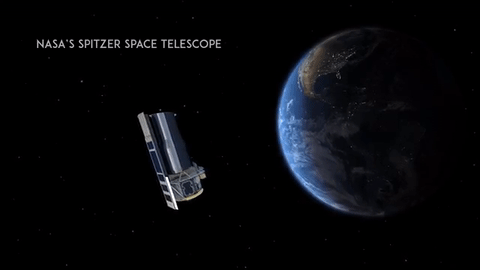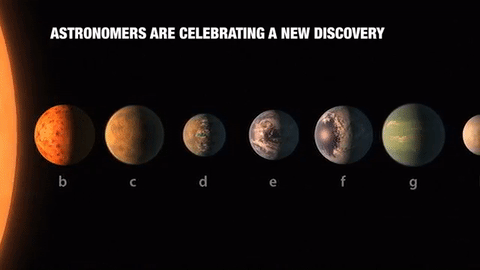Infographic - Blog Posts
Largest Batch of Earth-size, Habitable Zone Planets
Our Spitzer Space Telescope has revealed the first known system of seven Earth-size planets around a single star. Three of these planets are firmly located in an area called the habitable zone, where liquid water is most likely to exist on a rocky planet.

This exoplanet system is called TRAPPIST-1, named for The Transiting Planets and Planetesimals Small Telescope (TRAPPIST) in Chile. In May 2016, researchers using TRAPPIST announced they had discovered three planets in the system.

Assisted by several ground-based telescopes, Spitzer confirmed the existence of two of these planets and discovered five additional ones, increasing the number of known planets in the system to seven.

This is the FIRST time three terrestrial planets have been found in the habitable zone of a star, and this is the FIRST time we have been able to measure both the masses and the radius for habitable zone Earth-sized planets.
All of these seven planets could have liquid water, key to life as we know it, under the right atmospheric conditions, but the chances are highest with the three in the habitable zone.

At about 40 light-years (235 trillion miles) from Earth, the system of planets is relatively close to us, in the constellation Aquarius. Because they are located outside of our solar system, these planets are scientifically known as exoplanets. To clarify, exoplanets are planets outside our solar system that orbit a sun-like star.

In this animation, you can see the planets orbiting the star, with the green area representing the famous habitable zone, defined as the range of distance to the star for which an Earth-like planet is the most likely to harbor abundant liquid water on its surface. Planets e, f and g fall in the habitable zone of the star.
Using Spitzer data, the team precisely measured the sizes of the seven planets and developed first estimates of the masses of six of them. The mass of the seventh and farthest exoplanet has not yet been estimated.

For comparison…if our sun was the size of a basketball, the TRAPPIST-1 star would be the size of a golf ball.
Based on their densities, all of the TRAPPIST-1 planets are likely to be rocky. Further observations will not only help determine whether they are rich in water, but also possibly reveal whether any could have liquid water on their surfaces.
The sun at the center of this system is classified as an ultra-cool dwarf and is so cool that liquid water could survive on planets orbiting very close to it, closer than is possible on planets in our solar system. All seven of the TRAPPIST-1 planetary orbits are closer to their host star than Mercury is to our sun.

The planets also are very close to each other. How close? Well, if a person was standing on one of the planet’s surface, they could gaze up and potentially see geological features or clouds of neighboring worlds, which would sometimes appear larger than the moon in Earth’s sky.

The planets may also be tidally-locked to their star, which means the same side of the planet is always facing the star, therefore each side is either perpetual day or night. This could mean they have weather patterns totally unlike those on Earth, such as strong wind blowing from the day side to the night side, and extreme temperature changes.

Because most TRAPPIST-1 planets are likely to be rocky, and they are very close to one another, scientists view the Galilean moons of Jupiter – lo, Europa, Callisto, Ganymede – as good comparisons in our solar system. All of these moons are also tidally locked to Jupiter. The TRAPPIST-1 star is only slightly wider than Jupiter, yet much warmer.
How Did the Spitzer Space Telescope Detect this System?
Spitzer, an infrared telescope that trails Earth as it orbits the sun, was well-suited for studying TRAPPIST-1 because the star glows brightest in infrared light, whose wavelengths are longer than the eye can see. Spitzer is uniquely positioned in its orbit to observe enough crossing (aka transits) of the planets in front of the host star to reveal the complex architecture of the system.

Every time a planet passes by, or transits, a star, it blocks out some light. Spitzer measured the dips in light and based on how big the dip, you can determine the size of the planet. The timing of the transits tells you how long it takes for the planet to orbit the star.

The TRAPPIST-1 system provides one of the best opportunities in the next decade to study the atmospheres around Earth-size planets. Spitzer, Hubble and Kepler will help astronomers plan for follow-up studies using our upcoming James Webb Space Telescope, launching in 2018. With much greater sensitivity, Webb will be able to detect the chemical fingerprints of water, methane, oxygen, ozone and other components of a planet’s atmosphere.
At 40 light-years away, humans won’t be visiting this system in person anytime soon…that said…this poster can help us imagine what it would be like:

Make sure to follow us on Tumblr for your regular dose of space: http://nasa.tumblr.com






FROM EARTH TO SPACE: Where space begins and Earth’s atmosphere starts to fade away


The maximum life span is a theoretical number whose exact value cannot be determined from existing knowledge about an organism; it is often given as a rough estimate based on the longest lived organism of its species known to date. A more meaningful measure is the average life span; this is a statistical concept that is derived by the analysis of mortality data for populations of each species. A related term is the expectation of life. Life expectancy represents the average number of years that a group of persons, all born at the same time, might be expected to live, and it is based on the changing death rate over many past years.
The concept of life span implies that there is an individual whose existence has a definite beginning and end. What constitutes the individual in most cases presents no problem: among organisms that reproduce sexually the individual is a certain amount of living substance capable of maintaining itself alive and endowed with hereditary features that are in some measure unique. In some organisms, however, extensive and apparently indefinite growth takes place and reproduction may occur by division of a single parent organism, as in many protists, including bacteria, algae, and protozoans. In order to consider life span in such organisms, the individual must be defined arbitrarily since the organisms are continually dividing. In a strict sense, the life spans in such instances are not comparable to those forms that are sexually produced.
There is a brief period during which it is impossible to say whether an organism is still alive, but this time is so short relative to the total length of life that it creates no great problem in determining life span.
Some organisms seem to be potentially immortal. Unless an accident puts an end to life, they appear to be fully capable of surviving indefinitely. This faculty has been attributed to certain fishes and reptiles, which appear to be capable of unlimited growth. Without examining the various causes of death in detail, a distinction can be made between death as a result of internal changes (i.e., aging) and death as a result of some purely external factor, such as an accident. It is notable that the absence of aging processes is correlated with the absence of individuality. In other words, organisms in which the individual is difficult to define, as in colonial forms, appear not to age.
[Continue Reading→]

6 Social Media Trends That Will Take Over 2017 (Infograpic by Sprout Socia)l









12 Social Media Marketing Mistakes To Avoid!
Here are some of the common mistakes that marketers make on social media. But the good news is these mistakes can be avoided through strategic treatment of every day social media postings and campaigns.
Find out more on Slideshare: http://www.slideshare.net/AyeshaAmbreen/12-social-media-marketing-mistakes-to-steer-clear-of

Double update today!
This is excluding the female leaders of countries because they have a much more complicated relationship with defining how feminine they are. I also excluded all biological mothers besides Lily. Also I ran out of room.
(Also I heard this was international women's day so this fits.)
